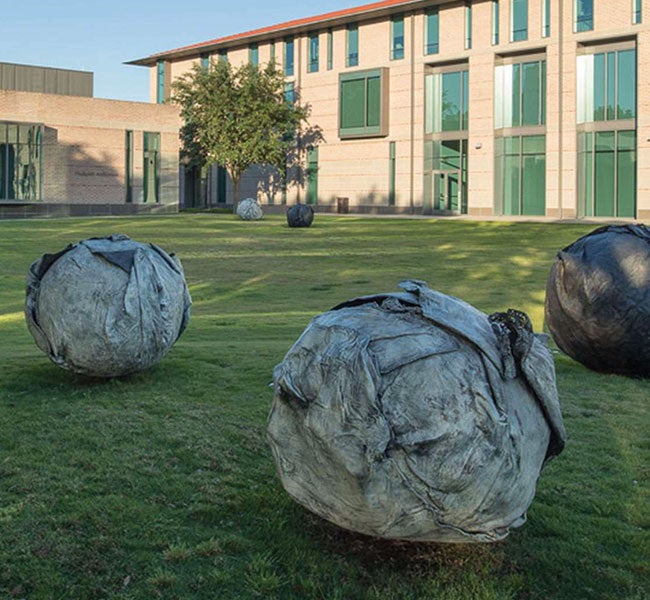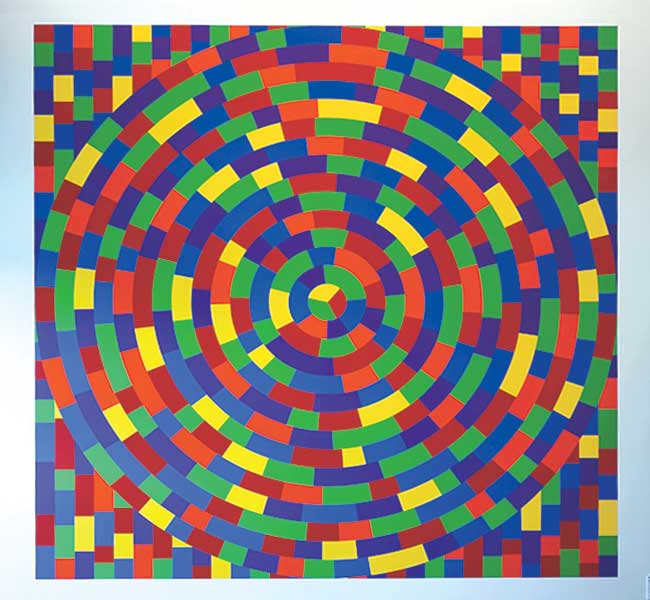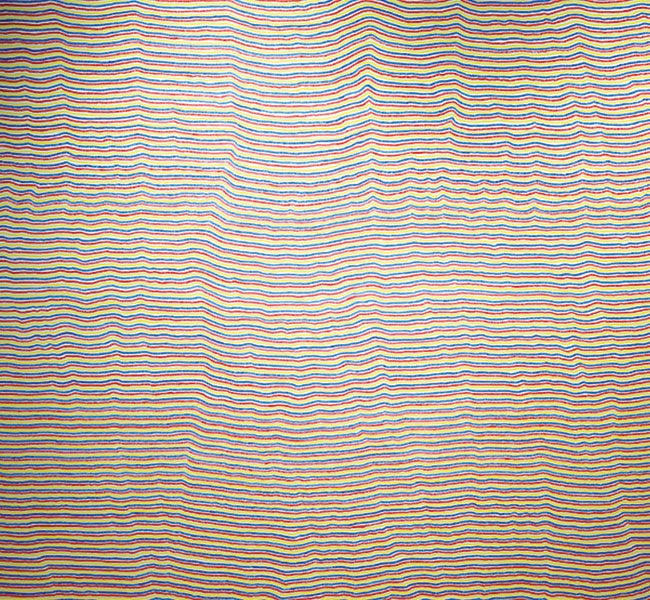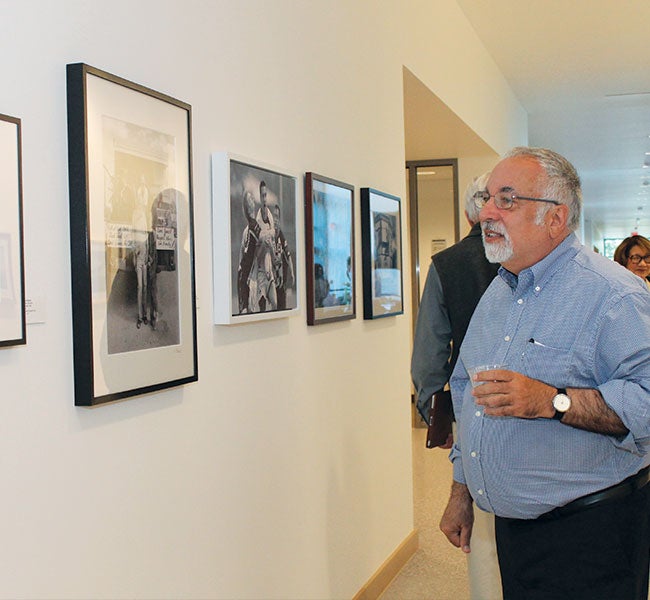
Aluminum and dichroic glass
Anderson-Clarke Center, Susanne M. Glasscock School of Continuing Studies Grand Staircase
Made possible by the generosity of H. Russell Pitman ’58
Black Ladder
Stephen Dean
Black Ladder employs varied panels of dichroic glass framed within the form of a ladder to fill the entire width and height of the stairwell window, set into the façade of the building. Natural light will filter through the glass during the day, projecting an array of color onto the floors and wall. After dark, the sculpture is lit so as to be visible to those within the building and passersby outside. The ladder, a symbol of upward movement and possibilities, reflects both its physical location in a stairwell and the mission of the Glasscock School, to serve as a conduit for personal and professional development growth.
About the artist: Born in Paris, France, Stephen Dean works in multiple media, including film, sculpture and drawing. Working across these media, Dean often uses color as a mechanism to alter spatial relationships. He is also interested in using the vocabulary of ritualized gatherings and everyday performance to reconstitute our systems of understanding space and time. Dean’s work has been exhibited at the San Francisco Museum of Modern Art, Miami Art Museum and the Site Santa Fe Biennial. His work is in many private and public collections, including the Whitney Museum of American Art, the National Gallery of Art, the Guggenheim Museum and the Progressive Corporation.

Patinaed bronze
Anderson-Clarke Center, Susanne M. Glasscock School of Continuing Studies Great Lawn
Made possible by the generosity of Leslie ’69 and Brad Bucher ’65
In Play
Joseph Havel
Each sculpture was cast of bronze using a fabric form, confounding the material nature of the sculpture. At first glance, the orbs appear heavy and dense as traditional bronze sculptures. In fact, their hollow and intricate construction challenges the viewer’s expectations, where upon closer inspection detailed traces of the original cloth and lace forms are apparent on the surface. The surface patinas were applied with both hot and cold coats of patina. The darker orbs were buffed to reveal flashes of their metallic base surfaces while the white orbs remained untouched. They were then coated with two layers of a sealer, a matting agent, and, finally waxed to protect their surfaces.
The sculptures are in dialogue in two groupings; one on the southwest corner and the other on the northeast corner of the lawn. The sculptures convey a lightness in their positioning; they appear to hover over the grass, as if they could be easily nudged or rolled. In Play invites intimate inspection, contemplation and a rethinking of the ideas sculpture can communicate.
About the artist: Born in Minnesota, Joseph Havel is a sculptor who has worked in bronze, resin and fiber. Havel’s work weaves together personal narrative and larger historical forces. The juxtaposition of divergent materials (here, bronze and cloth) and a trompe l’oeil sensibility are common themes found in Havel’s work, which also comments on Minimalism and the construction of identity. His work has been exhibited widely in the United States and Europe, and is in the collections of many museums, including the Pompidou Center, the Whitney Museum of American Art and the Modern Art Museum of Fort Worth. In 1987 he was awarded a National Endowment for the Arts Artist Fellowship and in 1995 he received a Louis Comfort Tiffany Artist’s Fellowship. Havel lives and works in Houston, and is Director of the Glassell School of Art. Havel holds a B.F.A. from the University of Minnesota and a M.F.A. from Pennsylvania State University.

Sol LeWitt Wall Drawing #1115
Circle within a square, each with broken bands of color
Sol LeWitt’s “Wall Drawing #1115: Circle within a square, each with broken bands of color” is a 14 by 14 foot square work that adorns a two-story wall in the Dean’s Commons of the Anderson-Clarke Center, the central convening space of our school. More than 500 painted “bands” of varying sizes, shapes and colors comprise this artwork, forming interwoven circles and exuding a powerful energy and a sense of interconnection.
A team of professional draftspeople meticulously installed Wall Drawing #1115 over four weeks in October and November, 2019. The team was led by Gabriel Hurier from the Sol LeWitt studio with the collaboration of Houston artist-installers David Krueger, Cat McCaulley and Jacob Villalobos.
First installed in 2004 at the Rhode Island School of Design Museum of Art, Wall Drawing #1115 is a permanent acquisition of Rice Public Art, the first work of conceptual art in Rice’s collection, and a generous gift to Rice University from H. Russell Pitman.
About the artist: Sol LeWitt (1928–2007) was an American artist whose work and ideas played a pivotal role in establishing Minimalism and Conceptual art. A pioneer in elevating ideas as an art form, LeWitt’s abundant body of work includes more than 1,270 wall drawings as well as many other forms of art. LeWitt’s wall drawing, “Glossy and Flat Black Squares” was Rice Gallery’s first site-specific work in 2007 and was re-installed as the gallery’s final exhibition in 2017. As Kimberly Davenport, founding director of Rice Gallery, said: “Sol figured out how to make art eternal. That was his genius.”
Visit the Sol LeWitt Project website to learn more.
Image caption: Sol LeWitt Wall Drawing #1115: Circle within a square, each with broken bands of color, 2004. Acrylic paint, dimensions variable. First drawn by: Takeshi Arita, Patrick Gavin, Glenn LaVertu, Laura Ostrander, Sara Saltzman. First Installation: Rhode Island School of Design Museum of Art, Providence, RI, February 2004. SL-439-WD. Current installation at Rice University drawn by: Gabriel Hurier, David Krueger, Cat McCaully, Jacob Villalobos, November 2019. Photo credit: Bret Newcomb. A gift to Rice University from H. Russell Pitman ’58.

Sol LeWitt Wall Drawing #869A
Copied lines
In November 2019, 36 Glasscock School and Rice community members installed a “copied lines” wall drawing of 300 “not straight horizontal” lines drawn freehand. John Hogan, the Mary Jo and Ted Shen Installations Director and Archivist for Sol LeWitt Wall Drawings at the Yale University Art Gallery, visited for a one-day training.
Led by Glasscock School studio art instructors Ellen Orseck and Laura Spector and Rice Visual and Dramatic Arts (VADA) faculty Josh Bernstein and Natasha Bowdoin with support from seven Glasscock School lifelong learners and six Rice undergraduates from the VADA and Architecture departments, the installation team also included 19 Rice and Glasscock alumni, staff and stakeholders.
Wall Drawing #869A has never before been installed anywhere in the world. It is a generous loan from Paula Cooper Gallery, New York and will be on display on the second floor of the Glasscock School for three years. At the end of that time, the loaned wall drawing must be painted over and photographic documentation of its destruction provided to Paula Cooper Gallery. If the work is later loaned to or acquired by another institution, it can come to life again, a demonstration of the wall drawing’s concept living on and transcending place and time.
About the artist: Sol LeWitt (1928–2007) was an American artist whose work and ideas played a pivotal role in establishing Minimalism and Conceptual art. A pioneer in elevating ideas as an art form, LeWitt’s abundant body of work includes more than 1,270 wall drawings as well as many other forms of art. LeWitt’s wall drawing, “Glossy and Flat Black Squares” was Rice Gallery’s first site-specific work in 2007 and was re-installed as the gallery’s final exhibition in 2017. As Kimberly Davenport, founding director of Rice Gallery, said: “Sol figured out how to make art eternal. That was his genius.”
Visit the Sol LeWitt Project website to learn more.
Image caption: Sol LeWitt Wall Drawing #869A: Copied Lines. From the top of a 96-inch (240 cm) square, using a marker or crayon, draw a not straight horizontal line. The line is black. The second line is drawn by another person, using another color, beneath the first line, as close as possible, imitating the black line. The next line is drawn in another color beneath the second line. Each color is drawn by a different person, and is continued, in the same sequence, to the bottom of the square. The black line (the first line) is not repeated. Continue to the bottom of the square with the last complete line. Marker or crayon, black pencil 96 x 96 in. (243.8 x 243.8 cm). First drawn by: Milagros Lugo Amador, Josh Bernstein, Natasha Bowdoin, Elin Britton, Korin Brody, Barb Brooks, Robert Bruce, Kiae Choi, Kathleen Huggins Clarke, Robert L. Clarke, Lola Deng, Anna Fritz, Mel Glasscock, Susanne Glasscock, John Hogan, Gabriel Hurier, Stanley Kaminski, David Krueger, Ann Scully Malcolm, Cathy Maris, Cat McCaully, Mary McIntire, Deborah Melanson, Ellen Orseck, Sophie Parker, Braden Perryman, Andy Rodriguez, Izzy Samperio, Anne Santos, John Sparagana, Laura Spector, Anne Swanson, Courtney Tardy, Jacob Villalobos, Jenny Wang, Alison Weaver, Ken Yanowski. First Installation: Rice University, Glasscock School of Continuing Studies, November, 2019 SL-458-WD. Photo credit: Bret Newcomb. The LeWitt Estate and Paula Cooper Gallery, New York. Loan courtesy of Paula Cooper Gallery, New York

Anderson-Clarke Center, Susanne M. Glasscock School of Continuing Studies
Made possible by the generosity of the students of Peter Brown
Peter T. Brown Gallery
The Peter T. Brown Gallery, housed in the Anderson-Clarke Center, was funded by more than $100,000 in donations from students.
Peter Brown has an extended relationship with the Susanne M. Glasscock School of Continuing Studies that expands beyond the school to the entire Houston community. Mary McIntire, dean of Continuing Studies, traces his history with the city: “Peter has been not only a superb teacher but also a mentor to more than a thousand adults with a passion for photography. Many of these people have gone on to become professional photographers, active as board members in the nonprofit arts scene and frequent contributors to photography exhibitions. It speaks so well of Peter that his current and past students – and these are non-credit courses – would contribute so generously, all the while keeping from Peter their plan to name the gallery in his honor. Peter has helped to create the vibrant arts scene in the city, and we are all grateful for his many contributions.” In 2008, in honor of his prolonged association with the school, Peter received the first Glasscock School Teaching Award in recognition of his 30 years as a community instructor for Continuing Studies.
Thank you for the efforts and generosity of all who donated money and time to fund and coordinate the space including Julie Alexander, Lloyd Bentsen, John D. Chaney, Kelly Dempster, Patricia Eifel and Jim Belli, Tom Flaherty, Sandy Lloyd, Mary McIntire and Jim Pomerantz, Bill Walterman and the students of Peter T. Brown.
The gallery is located between the Dean’s Commons and Hudspeth Auditorium in the Anderson-Clarke Center and will be host to many future exhibitions.
Connect with the Glasscock School
POSTAL ADDRESS
Rice University Susanne M. Glasscock School of Continuing Studies - MS-550
P.O. BOX 1892
Houston, TX 77251-1892
STREET ADDRESS
Susanne M. Glasscock School of Continuing Studies - MS-550
Anderson-Clarke Center
Rice University
6100 Main Street
Houston, TX 77005
